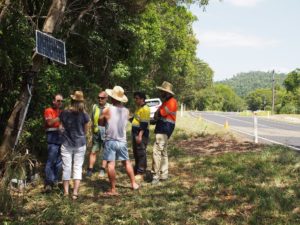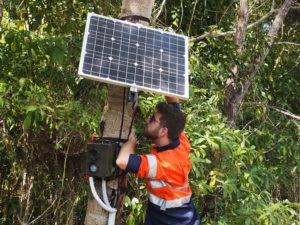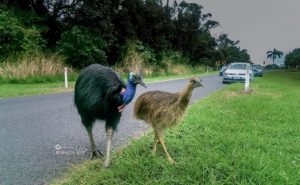Reducing the road toll for the iconic and endangered cassowaries
Story originally published by Terrain NRM on 26/11/2019.
Cassowaries will be captured on camera in a new project to reduce the road toll for the iconic and endangered birds. Cameras have been installed at cassowary crossing hotspots on Far Northern roads and they will be in place for one year as part of the Queensland Government and CSIRO-funded project which is also a partnership with Terrain NRM and the Cassowary Recovery Team.
The footage will be used to learn more about both cassowary and driver behaviour.
“Vehicle strike is the leading recorded cause of cassowary deaths,” Terrain NRM’s Tony O’Malley said. “Some great solutions have been implemented over the years, however vehicle strikes continue.
“These new smart cameras will capture in detail the interactions between cassowaries, roads and drivers and increase our understanding of how cassowaries and drivers behave around each other. The findings will help identify effective solutions to improve cassowary and driver awareness and safety.”
The project follows a successful two-week trial on the Tully-Mission Beach Road earlier this year.
Transport and Main Roads Minister Mark Bailey said the Queensland Government was committed to working with the community and other agencies such as Terrain NRM, the Cassowary Recovery Team and CSIRO to help reduce the risk of cassowary road strike.
It adds to existing initiatives like:
- Vegetation management along key roads in the Mission Beach area, to increase cassowary chicks visibility during the breeding season.
- Variable Message Signs installation on Kuranda Range Road, which are used to notify drivers of road hazards, including cassowary sightings.
- Bluetooth loggers installation to identify trends in driver behaviour in the Cassowary Coast region.
- The launch of the ‘Report a cassowary’ feature on the QLDTraffic App.
- Vehicle Activated Sign trails on the Tully Mission Beach Road at Carmoo.
It also adds to progress on the world’s first dedicated cassowary land bridge linking tracts of world heritage-listed rainforest on the Bruce Highway at Smiths Gap.
“We want to protect the cassowary,” Mr Bailey said. “This project will assist us in understanding interactions between cassowaries and road users. We will continue to work with the community to find effective and innovative solutions to reduce cassowary vehicle strikes.”
Mr O’Malley said local cassowary groups would help to monitor the equipment, which has been installed on the El Arish-Mission Beach Rd and Tully-Mission Beach Rd.
Reducing dangerous interactions between cassowaries and vehicles is part of a larger four-year Rainforest Resilience project that also focuses on improving rainforest habitat in the Wet Tropics through grants and incentives for revegetation, weed management and habitat protection. The Rainforest Resilience project is supported by Terrain NRM through funding from the Australian Government’s National Landcare Program.
- The project team. Photo published by Terrain NRM via Facebook.
- Team installing cameras. Photo published by Terrain NRM via Facebook.
- Cassowary photo by Rob Onnis, PHiMAGES, published by Terrain NRM via Facebook.
Story originally published by Terrain NRM on 26/11/2019.
To learn more, contact us.
[jetpack_subscription_form title=”Subscribe to our News via Email” subscribe_text=”Enter your email address to subscribe and receive notifications of new posts by email.”]



